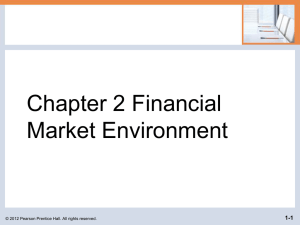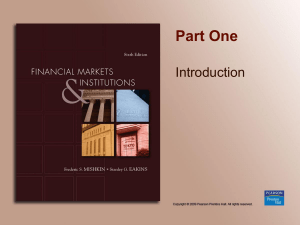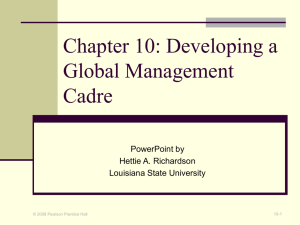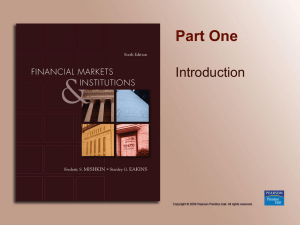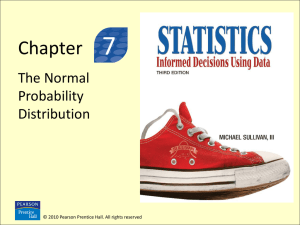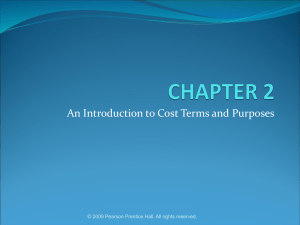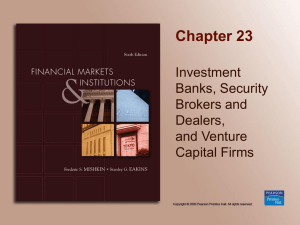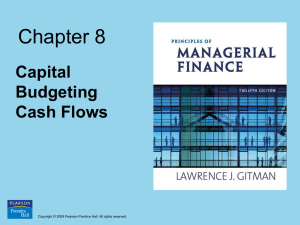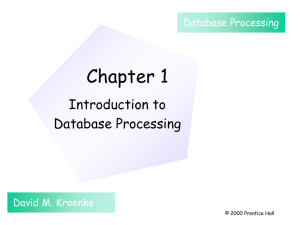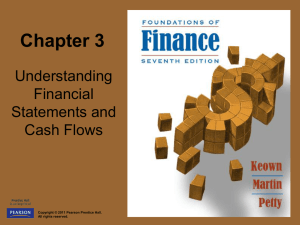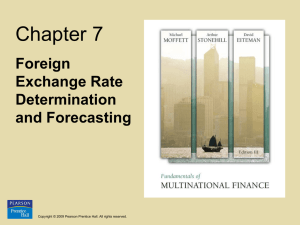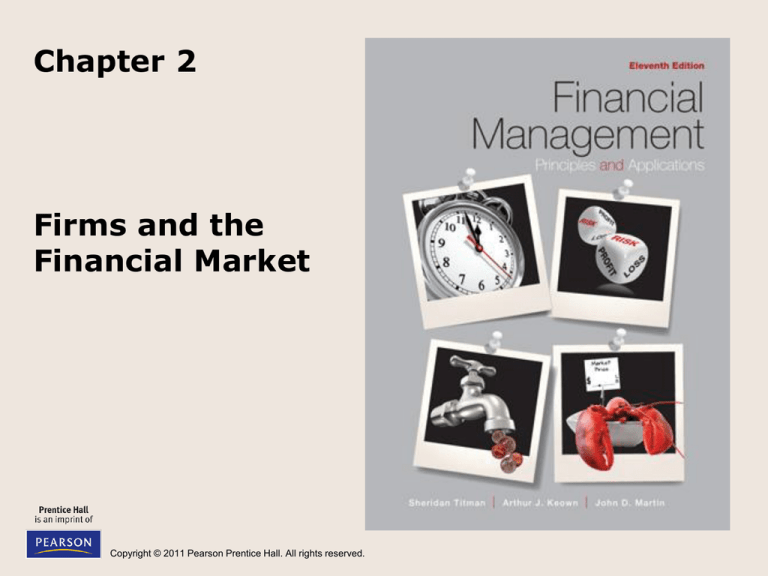
Chapter 2
Firms and the
Financial Market
Copyright © 2011 Pearson Prentice Hall. All rights reserved.
Three Players in the Financial
Markets (cont.)
1. Borrowers: Individuals and businesses that need
money to finance their purchases or
investments.
2. Savers (Investors): Those who have money to
invest. These are principally individuals although
firms also save when they have excess cash.
3. Financial Institutions (Intermediaries): The
financial institutions and markets help bring
borrowers and savers together.
Copyright © 2011 Pearson Prentice Hall. All rights reserved.
2-2
Financial Intermediaries
SAVERS
Copyright © 2011 Pearson Prentice Hall. All rights reserved.
Financial
Intermediaries
BORROWERS
2-3
Financial Intermediaries (examples)
•
•
•
•
Commercial Banks
Finance Companies
Insurance Companies
Investment Banks
• Help bring together those who have money
(savers) and those who need money
(borrowers).
Copyright © 2011 Pearson Prentice Hall. All rights reserved.
2-4
Commercial Banks – Everyone’s
Financial Marketplace
• Commercial banks collect the savings of
individuals as well as businesses and then lend
those pooled savings to other individuals and
businesses.
• They make money by charging a rate of interest
to borrowers that exceeds the rate they pay to
savers.
• In the United States, commercial banks cannot
own industrial corporations.
Copyright © 2011 Pearson Prentice Hall. All rights reserved.
2-5
Copyright © 2011 Pearson Prentice Hall. All rights reserved.
2-6
Investment Banks
• Investment banks are specialized
financial intermediaries that:
– help companies and governments raise money
– provide advisory services to client firms on
major transactions such as mergers
• Firms that provide investment banking
services include Bank of America, Goldman
Sachs, Morgan Stanley and JP Morgan
Chase.
Copyright © 2011 Pearson Prentice Hall. All rights reserved.
2-7
Security
• A security is a negotiable instrument that
represents a financial claim and can take
the form of ownership (such as stocks) or
debt agreement (such as bonds).
• The securities market allow businesses and
individual investors to trade the securities
issued by public corporations.
Copyright © 2011 Pearson Prentice Hall. All rights reserved.
2-8
Primary versus Secondary Market
• A primary market is a market in which
securities are bought and sold for the first
time. In this market, the firm selling
securities actually receives the money
raised. For example, securities sold by a
corporation to an investment bank.
Copyright © 2011 Pearson Prentice Hall. All rights reserved.
2-9
Primary versus Secondary Market
(cont.)
• A secondary market is where all
subsequent trading of previously issued
securities takes place.
• In this market, the issuing firm does not
receive any new financing. The securities
are simply transferred from one investor to
another.
• Provide liquidity to the investor.
• Examples: New York Stock Exchange;
NASDAQ
Copyright © 2011 Pearson Prentice Hall. All rights reserved.
2-10
Types of Securities
• Debt Securities: Firms borrow money by
selling debt securities in the debt market.
• If the debt has a maturity of less than one
year, it is typically called notes, and is
traded in the money market.
• If the debt has a maturity of more than
one year, it is called bond and is traded in
the capital market.
Copyright © 2011 Pearson Prentice Hall. All rights reserved.
2-11
Types of Securities (cont.)
• Equity securities represent ownership of
the corporation.
• There are two major types of equity
securities: common stock and preferred
stock.
Copyright © 2011 Pearson Prentice Hall. All rights reserved.
2-12
Types of Securities (cont.)
• Common stock is a security that represents
equity ownership in a corporation, provides voting
rights, and entitles the holder to a share of the
company’s success in the form of dividends and
any capital appreciation in the value of the
security.
• Common stockholders are residual owners of the
firm i.e. they earn a return only after all other
security holder claims (debt and preferred equity)
have been satisfied in full.
Copyright © 2011 Pearson Prentice Hall. All rights reserved.
2-13
Types of Securities (cont.)
• Dividends on common stock are neither
fixed nor guaranteed. Thus a company can
choose to reinvest all of the profits in a
new project or re-purchase its own stock
and pay no dividends to common
shareholders.
Copyright © 2011 Pearson Prentice Hall. All rights reserved.
2-14
Types of Securities (cont.)
• Preferred stock is also an equity
security.
• Preferred stockholders have preference
with regard to:
– Dividends: They are paid before the common
stockholders are.
– Claim on assets: They are paid before common
stockholders if the firm goes bankrupt and sells
or liquidates its assets.
Copyright © 2011 Pearson Prentice Hall. All rights reserved.
2-15
Types of Securities (cont.)
• Preferred stock is also referred to as a
hybrid security as it has features of both
common stock and bonds.
Copyright © 2011 Pearson Prentice Hall. All rights reserved.
2-16
Types of Securities (cont.)
• Preferred stock is similar to common stocks
in that:
– It has no fixed maturity date,
– The nonpayment of dividends does not result in
bankruptcy of the firm, and
– The dividends are not deductible for tax
purposes.
Copyright © 2011 Pearson Prentice Hall. All rights reserved.
2-17
Types of Securities (cont.)
Preferred stock is similar to corporate bonds
in that:
– The dividends are typically a fixed amount, and
– There are no voting rights.
Copyright © 2011 Pearson Prentice Hall. All rights reserved.
2-18
Stock Markets
• A stock market is a public market in which
the stocks of companies are traded.
• Stock markets are classified as either
organized security exchanges or an overthe-counter (OTC) market.
Copyright © 2011 Pearson Prentice Hall. All rights reserved.
2-19
Stock Markets (cont.)
• Organized security exchanges are
tangible entities; that is, they physically
occupy space and financial instruments are
traded on their premises.
• For example, the New York Stock
Exchange (NYSE) is located at 11 Wall
Street in Manhattan, NY.
Copyright © 2011 Pearson Prentice Hall. All rights reserved.
2-20
Stock Markets (cont.)
• The over-the-counter markets include all
security markets except the organized exchanges.
• NASDAQ (National Association of Securities
Dealers Automated Quotations) is an over-thecounter market and describes itself as a “screenbased, floorless market”.
• In 2009, nearly 3,900 companies were listed on
NASDAQ, including Starbucks, Google, and Intel.
Copyright © 2011 Pearson Prentice Hall. All rights reserved.
2-21
Copyright © 2011 Pearson Prentice Hall. All rights reserved.
2-22
Other Financial Instruments
• Table 2-2 in your text provides a list of
different financial instruments used by
firms to raise money beginning with the
shortest maturity instruments that are
traded in the money market and moving
through to the longest maturity
instruments that are traded in the capital
market.
Copyright © 2011 Pearson Prentice Hall. All rights reserved.
2-23
Copyright © 2011 Pearson Prentice Hall. All rights reserved.
2-24

